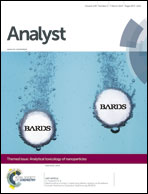Impedance nanopore biosensor: influence of pore dimensions on biosensing performance
Abstract
Knowledge about electrochemical and electrical properties of nanopore structures and the influence of pore dimensions on these properties is important for the development of nanopore biosensing devices. The aim of this study was to explore the influence of nanopore dimensions (diameter and length) on biosensing performance using non-faradic electrochemical impedance spectroscopy (EIS). Nanoporous alumina membranes (NPAMs) prepared by self-ordered electrochemical anodization of aluminium were used as model nanopore sensing platforms. NPAMs with different pore diameters (25–65 nm) and lengths (4–18 μm) were prepared and the internal pore surface chemistry was modified by covalently attaching streptavidin and biotin. The performance of this antibody nanopore biosensing platform was evaluated using various concentrations of biotin as a model analyte. EIS measurements of pore resistivity and conductivity were carried out for pores with different diameters and lengths. The results showed that smaller pore dimensions of 25 nm and pore lengths up to 10 μm provide better biosensing performance.


 Please wait while we load your content...
Please wait while we load your content...